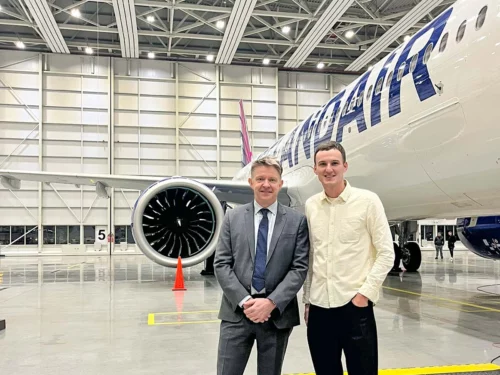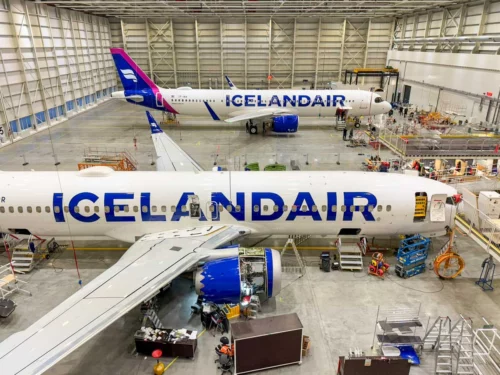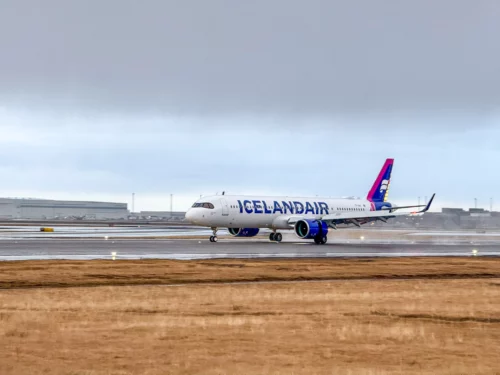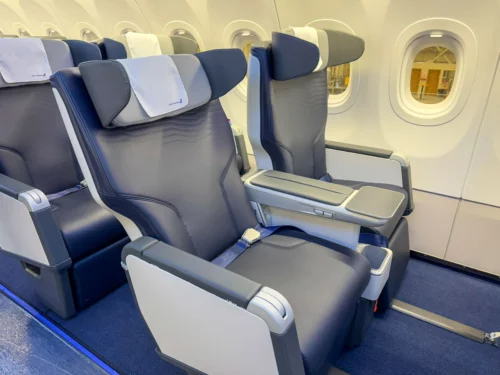We chat to Icelandair CEO Bogi Bogason: Lie-flat business class, alliance membership and more
Links on Head for Points may support the site by paying a commission. See here for all partner links.
Last week, Icelandair took delivery of its very first Airbus – an A321LR – in its 87-year history. The milestone was marked with a launch event at Keflavik Airport, the airline’s home hub. You can read my report about that day here as well as what the A321neo will bring to Icelandair.
I had the chance to speak to Icelandair CEO Bogi Nils Bogason to discuss the airline’s unique (in Europe) business model as well as what we can expect in the future.
Amongst European airlines Icelandair stands out. Iceland has a total population of just under 400,000 people, so the home market is remarkably small. The airline makes up for it by leveraging its unique position in the North Atlantic to attract passengers that are happy to connect, either because they prefer it or they are more price sensitive.
“In an average year, around 50% of our passengers are connecting in Iceland between the continents but that varies a little bit from year to year, based on the market dynamics and so on. This year, it will be around somewhere between 45% and 50% of North Atlantic passengers.
And the market to Iceland is normally tourists coming to Iceland, 35% of our passengers, and then the remaining are Icelanders travelling abroad. So that is very important market for us. But the international market is 85%, if you combine the transfer traffic and the tourist market to Iceland.”
The arrival of Icelandair’s A321LR – its first Airbus – marks the latest phase of its fleet renewal. It is moving from Boeing 757 and 767 aircraft with an average age of 25 years to a family of next-generation models.
“It is a big milestone for Icelandair to take delivery of the first Airbus in the 87 year history of the company. Very big milestone. And as I have been saying, we see a lot of opportunities to bring this aircraft in as a replacement for the Boeing 757. It is much more fuel efficient – 30%. That will definitely create a lot of opportunities and support our sustainability goals.
“The 757 has been a great aircraft for us, but the A321LR has 187 seats whilst the 757 has 183, so it is just a logical step in the in our fleet strategy.”
The A321neos that Icelandair is receiving have the potential to open new opportunities. For example, the airline does not currently fly to San Francisco or LA – two hubs you’d expect it to serve.
“We can fly to California on the Boeing 767 and we have done it in the past. But when we get the A321XLR – we have 13 aircraft like that will on order they will start to come in in 2029 – that will open up opportunities in California, like LA and San Francisco and so on. And being able to fly on the most fuel efficient narrow body aircraft to destinations like that from Iceland will create a lot of lot of opportunities to develop the network further.”
Narrow bodies are Icelandair’s bread and butter, although it does have a few widebodies:
“We have three 767s, and they are doing quite well for us. We have been using them on routes where we have high demand, and sometimes some slot restrictions. We also use them into destinations where we have a strong demand for cargo, fresh fish, fresh salmon, down to the east coast of the US and to Europe as well.
“But our business model is about operating the most efficient narrow body aircraft from Iceland to connect the continents via Iceland. Because of high demand into some airports, we saw a big opportunity for for the 767. And we will keep on operating the 767 for few more years at least.”
Is the plan to move to an all narrow body fleet?
“We are soon going to start a strategy project, an analysis regarding the future of widebodies in our fleet. This is something that we’re gonna study in the in the coming months. We have not decided if we want a widebody yet and the work is a little bit about that.”
Icelandair’s new Airbus A321LR continues its strategy of offering a recliner business class cabin rather than lie-flat seating that we’ve seen at other airlines, including Iberia. But with some flights as long as seven or eight hours, should we expect to see lie-flat seating come eventually?
“We revisit that option almost every third year. There is definitely revenue potential there from business travellers from Seattle, for example. But we use the same aircraft for all our European destinations including short flights to Glasgow, Oslo and so on.
Even though there is revenue potential, the conclusion has always been to stick to this product here, a very good business class product, even though it’s not lie-flat, because there is not a high demand for lie-flat products from short destinations in Europe.”
And what about alliance membership? Icelandair’s position in the North Atlantic is not just geographically remote but also a long way from alliance membership. It is bounded East and West by strong competition from all three alliances, with SkyTeam, oneworld and Star Alliance all represented by large carriers on both sides of the Atlantic.
“We look at that quite thoroughly, quite regularly as well, and the conclusion has been the same. What we have been doing in our strategy is to partner with other airlines, and that is a very important part of our strategy and business model.
“So we have been partnering with airlines like Alaska on the West Coast of the US, JetBlue on the East Coast, SAS and Finnair here in Scandinavia. And then recently, we added Turkish Airlines last year, Emirates this year. And we also announced that we will be the first airline partner of Southwest and by that, we will be very well covered in North America.
“That is our strategy, to partner with airlines and connect our networks. Equally, we also signed an agreement with Air Greenland and Atlantic Airways recently, strengthening the flight connections within the Arctic and also connecting the Arctic better to to Europe and North America through our strong strong hub here in Keflavik.”













Comments (23)